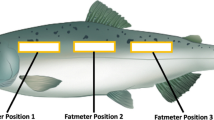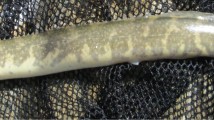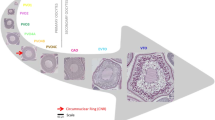Abstract
The indeterminate relationship between the total biomass of mature fish (spawner biomass) and the number of offspring produced (recruitment) has puzzled population dynamicists1 and impeded fisheries management2. The relationship assumes that spawner biomass (in tonnes) is proportional to the total number of eggs produced (TEP) by the stock3, an assumption under increasing challenge4,5,6,7,8. Most stocks require proxies for TEP because contemporary and/or historical fecundity data are lacking. Here we show a positive association between recruitment and the liver weights of spawners in the Barents Sea cod stock which suggests that recruitment is constrained by the amount of lipid energy stored in the liver. This stimulated our interest in estimating total lipid energy (TLE; in kilojoules) for mature females in the stock. We examined the suitability of TLE as a proxy through correlation and simulation analyses. The results indicate that TLE is proportional to TEP and exhibits a similar response to varying food abundance. Replacing spawner biomass with more accurate measures of reproductive potential is essential to developing a rational basis for stock conservation9. Correctly specifying the first-order maternal effect on TEP is a prerequisite to detecting environmental and ecological effects on recruitment10.
This is a preview of subscription content, access via your institution
Access options
Subscribe to this journal
Receive 51 print issues and online access
$199.00 per year
only $3.90 per issue
Buy this article
- Purchase on Springer Link
- Instant access to full article PDF
Prices may be subject to local taxes which are calculated during checkout


Similar content being viewed by others
References
Rothschild,B. J. Dynamics of Marine Fish Populations (Harvard Univ. Press, Cambridge, 1986).
Hilborn,R. & Walters,C. J. Quantitative Fisheries Stock Assessment: Choice, Dynamics and Uncertainty (Chapman and Hall, New York, 1992).
Beverton,R. J. H. & Holt,S. J. On the Dynamics of Exploited Fish Populations (Fish. Invest. Ministry of Agriculture Fish. Food Ser. II, Salmon Freshwater Fisheries, London, 1957).
Trippel,E. A., Kjesbu,O. S. & Solemdal,P. in Early Life History and Recruitment in Fish Populations (eds Chambers, R. C. & Trippel, E. A.) 31–62 (Chapman and Hall, London, 1997).
Marteinsdottir,G. & Thorarinsson,K. Improving the stock–recruitment relationship in Icelandic cod (Gadus morhua L.) by including age diversity of spawners. Can. J. Fish. Aquat. Sci. 55, 1372–1377 (1998).
Marshall,C. T., Kjesbu,O. S., Yaragina,N. A., Solemdal,P. & Ulltang,Ø. Is spawner biomass a sensitive measure of the reproductive and recruitment potential of Northeast Arctic cod? Can. J. Fish. Aquat. Sci. 55, 1766–1783 (1998).
Lowerre-Barbieri,S. K., Lowerre,J. M. & Barbieri,L. R. Multiple spawning and the dynamics of fish populations: inferences from an individual-based simulation model. Can. J. Fish. Aquat. Sci. 55, 2244–2254 (1998).
Marshall,C. T. & Frank,K. T. The effect of interannual variation in growth and condition on haddock recruitment. Can. J. Fish. Aquat. Sci. 56, 347–355 (1999).
Painting,S. J. et al. Environmental and biological monitoring for forecasting anchovy recruitment in the southern Benguela upwelling region. Fisheries Oceanography 7, 364–374 (1998).
Jarre-Teichmann,A. et al. Stock-recruitment relationships for cod (Gadus morhua callerias L.) in the central Baltic Sea incorporating environmental variability. ICES J. Mar. Sci. (in the press).
Lambert,Y. & Dutil,J.-D. Condition and energy reserves of Atlantic cod (Gadus morhua) during the collapse of the northern Gulf of St. Lawrence stock. Can. J. Fish. Aquat. Sci. 54, 2388–2400 (1997).
Lambert,Y. & Dutil,J.-D. Can simple condition indices be used to monitor and quantify seasonal changes in the energy reserves of Atlantic cod (Gadus morhua)? Can. J. Fish. Aquat. Sci. 54 (Suppl. 1), 104–112 (1997).
Yaragina,N. A. & Marshall,C. T. Trophic influences on seasonal and interannual variation in the liver condition index of Northeast Arctic cod (Gadus morhua). ICES J. Mar. Sci. (in the press).
Henderson,B. A., Wong,J. L. & Nepszy,S. J. Reproduction of walleye in Lake Erie: allocation of energy. Can. J. Fish. Aquat. Sci. 53, 127–133 (1996).
Henderson,B. A. & Wong,J. L. Control of lake trout reproduction: role of lipids. J. Fish Biol. 52, 1078–1082 (1998).
Adams,S. M. in Lipids in Freshwater Ecosystems (eds Arts, M. T. & Wainman, B. C.) 132–160 (Springer, New York, 1999).
Boyd,A. J., Shannon,L. J., Schülein,F. H. & Taunton-Clark,J. in Global versus Local Changes in Upwelling Systems (eds Durand, M.-H. et al.) 195–209 (Éditions de l'Orstom, Paris, 1998).
Report of the Arctic Fisheries Working Group ICES CM 1999/ACFM:3 (International Council for the Exploration of the Sea, Copenhagen, 1999).
Gjøsæter,H. The population biology and exploitation of capelin (Mallotus villosus) in the Barents Sea. Sarsia 83, 453–496 (1998).
Huggett,J. A., Boyd,A. J., Hutchings,L. & Kemp,A. D. Weekly variability of clupeoid eggs and larvae in the Benguela jet current: implications for recruitment. S. Afr. J. Mar. Sci. 19, 197–210 (1998).
Mukhina,N. V. The use of Russian ichthyoplankton survey data in the forecasting of recruitment to Arcto-Norwegian cod stock. ICES CM 1999/Y:15 (International Council for the Exploration of the Sea, Copenhagen, 1999).
Sargent,J. R., Bell,J. G., Bell,M. V., Henderson,R. J. & Tocher,D. R. Requirement criteria for essential fatty acids. J. Appl. Ichthyol. 11, 183–198 (1995).
Pickova,J., Dutta,P. C., Larsson,P.-O. & Kiessling,A. Early embryonic cleavage pattern, hatching success, and egg-lipid fatty acid composition: comparison between two cod (Gadus morhua) stocks. Can. J. Fish. Aquat. Sci. 54, 2410–2416 (1997).
Bell,M. V. & Sargent,J. R. Lipid nutrition and fish recruitment. Mar. Ecol. Prog. Ser. 134, 315–316 (1996).
Lawson,J. W., Magalhães,A. M. & Miller,E. H. Important prey species of marine vertebrate predators in the northwest Atlantic: proximate composition and energy density. Mar. Ecol. Prog. Ser. 164, 13–20 (1998).
Olsen,Y. in Lipids in Freshwater Ecosystems (eds Arts, M. T. & Wainman, B. C.) 161–202 (Springer, New York, 1999).
Frisch,R. E. Fatness and fertility. Sci. Am. 258, 88–95 (1988).
Boersma,M. & Vijverberg,J. Resource depression in Daphnia galeata, Daphnia cucullata and their interspecific hybrid: life history consequences. J. Plankton Res. 16, 1741–1758 (1994).
Kjesbu,O. S., Witthames,O. R., Solemdal,P. & Greer Walker,M. Temporal variations in the fecundity of Arcto-Norwegian cod (Gadus morhua) in response to natural changes in food and temperature. J. Sea Res. 40, 303–321 (1998).
Acknowledgements
We thank the staff at the Polar Research Institute of Marine Fisheries and Oceanography who maintained the liver condition database. This work was supported by the Norwegian Research Council (CTM), the Norwegian Foreign Department (NAY), the Canadian Department of Fisheries and Oceans (YL) and the European Union (OSK).
Author information
Authors and Affiliations
Corresponding author
Rights and permissions
About this article
Cite this article
Marshall, C., Yaragina, N., Lambert, Y. et al. Total lipid energy as a proxy for total egg production by fish stocks. Nature 402, 288–290 (1999). https://doi.org/10.1038/46272
Received:
Accepted:
Issue Date:
DOI: https://doi.org/10.1038/46272
This article is cited by
-
Oogenesis and lipid metabolism in the deep-sea sponge Phakellia ventilabrum (Linnaeus, 1767)
Scientific Reports (2022)
-
Individual spawning performance and mating pair combinations in captive grouper aggregations
Environmental Biology of Fishes (2022)
-
Capelin (Mallotus villosus) availability influences the inshore summer diet of Atlantic cod (Gadus morhua) in coastal Newfoundland
Environmental Biology of Fishes (2020)
-
Reproductive status of walleye (Sander vitreus) and lake whitefish (Coregonus clupeaformis) in two large, shallow Canadian subarctic lakes
Environmental Biology of Fishes (2020)
-
Biochemical impacts in adult and juvenile farmed European seabass and gilthead seabream from semi-intensive aquaculture of southern European estuarine systems
Environmental Science and Pollution Research (2019)
Comments
By submitting a comment you agree to abide by our Terms and Community Guidelines. If you find something abusive or that does not comply with our terms or guidelines please flag it as inappropriate.



